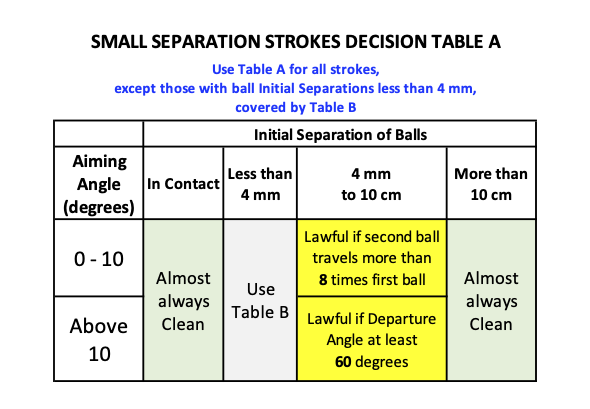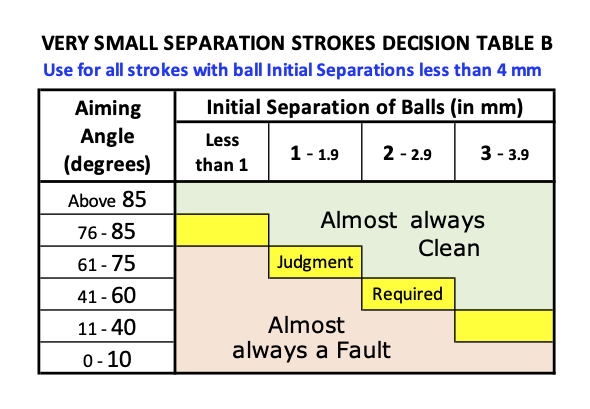
Guidance to Referees and Players on Strokes Involving Small Separations
Definitions and Abbreviations
All references to the GC Rules are to the 6th Edition.
Diagram 1 below defines the abbreviations used in this guidance:
- The aiming angle to the line of ball centres (AA), measured in degrees.
- The initial separation (IS) of the balls is measured in millimetres.
- Departure Angle (DA) - the angle, measured in degrees, at which the balls separate after impact.
- Striker's Ball (SB) - the ball to be struck by the mallet - the black ball in the diagram.
- Object Ball (OB) - the ball being moved by SB - the red ball in the diagram.

Diagram 1 - Abbreviations used in Small Separation Stroke Guidance
Introduction
Paragraph 4.1 of Appendix 5 of the GC Rules sets out the guidance (the 8:1 'rule') on a stroke that involves hitting a ball towards another ball more than 4 mm away, along, or close to, their line of centres. This is soundly based on the super slow-motion videos made by The Croquet Association at Bowdon in 2006.
Paragraph 4.2 of Appendix 5 addresses balls played at an angle to their line of centres.
Since that guidance was produced, to assist in adjudicating strokes involving balls less than 4 mm apart (defined as 'very small separation strokes'), a set of trigonometrical calculations have been used to identify the angles required to achieve 4 mm effective separation distances at different Initial Separations. The results are shown in Chart 1 below:

Chart 1 - Minimum Aiming Angle for a range of Initial Separations to Achieve a Clean Stroke.
Playing very small separation strokes at these, or greater, angles will thus avoid Crush Faults, because generally the striker's ball only stays in contact with mallet for about 4 mm.
The existence of this chart allows this guidance to override the final sentence of Para 4.2.2 of Appendix 5 "If the separation is less than 4 mm, the angle at which balls depart should be approaching 90 degrees to be sure of a lawful stroke.". Instead, the more consistent measure, the Aiming Angle of the mallet, should now be used to determine the ruling.
Small Separation Strokes
This supplementary, web-based guidance includes two tables, Tables A (based on assessing the Departure Angle) and B (based on observing the Aiming Angle of the mallet), below, to provide easy-to-use ready reckoners for adjudicating all Small Separation Strokes:


Table A (copy downloadable here) should be used to adjudicate all strokes involving balls with small initial separations, unless the Initial Separation is less than 4 mm (i.e. a Very Small Initial Separation), when Table B (copy downloadable here) is the relevant table.
This guidance also includes how to referee a Small Separation Stroke and the factors applicable when exercising judgement.
How to Referee Such Strokes
- Ask the player what they intend to do. The referee should establish:
- What is the player's intended line of aim and hence what AA they intend.
- The type of stroke that the player intends to play (i.e. firm/gentle, roll/stun/slice, etc.). While this is not a factor bearing on the lawfulness of the stroke, it will assist the referee in deciding where to stand to observe and what outcome to expect.
- Mark the balls' positions. It may also be useful to mark the intended AA using a marker placed behind the player.
- Check the separation between the balls along the line of centres. If the separation is less than 4 mm, be prepared to use Table B in adjudicating the stroke.
- Ask the player to play the stroke.
- Watch the stroke - was it along the intended AA; was it a well-executed shot?
- Apply the guidance given (using the appropriate Table A or Table B) to decide whether or not to declare a Fault under Rule 11.2.4 or 11.2.6.
Exercising Judgement
Note always that poorly played strokes with excessive or lazy follow-through will be likely to cause a Fault even in circumstances when a well-executed stop (stun) shot would not - this must be considered when refereeing a stroke.
Table B above identifies with yellow-coloured cells some marginal circumstances when a referee will need to rely more on their experience in making a judgment based on whether a Fault was more likely than not (in accordance with Rule 11.3.1).
For angled strokes, mindful of the minimum Aiming Angle require to achieve a 4 mm effective separation distance, as defined above (see Chart 1), referees will need to use all of:
- The Initial Separation.
- The Aiming Angle.
- The way the balls moved, including the Departure Angle (see below).
- The sound (N.B. not a very reliable guide).
- What happened with the mallet's follow through.
- Any interaction with a hoop / peg.
When played correctly at extreme angles, the Object Ball will not move very far at all - if it moves a significant distance, then there is likely to have been a Fault under Rule 11.2.6.



 Contents...
Contents...
 Using this website
Using this website

